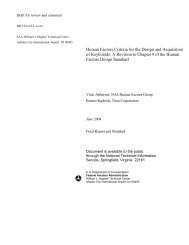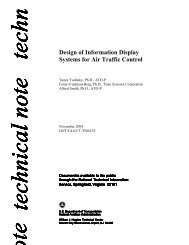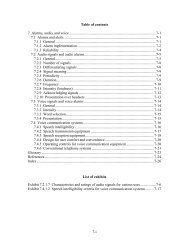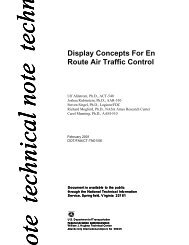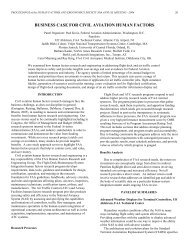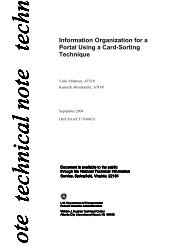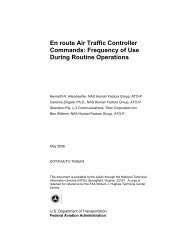Chapter 14. Anthropometry and Biomechanics - FAA
Chapter 14. Anthropometry and Biomechanics - FAA
Chapter 14. Anthropometry and Biomechanics - FAA
Create successful ePaper yourself
Turn your PDF publications into a flip-book with our unique Google optimized e-Paper software.
HFDS 2003 (amended Oct 2009)<strong>Chapter</strong> 14 <strong>Anthropometry</strong> <strong>and</strong> biomechanics<strong>14.</strong>2 Anthropometric variability factorsthe prediction. An R of .7 would account for about 50percent of the variation).There are many factors that relate to the large variabilityobserved in measures of the human body. These factors include:(1) body position, (2) age, health, <strong>and</strong> body condition, (3) sex,(4) race <strong>and</strong> national origin, (5) occupation, <strong>and</strong> (6) evolutionarytrends. These factors affect future population sampling <strong>and</strong>encourage the use of the most recent data on the populations ofinterest. If designers <strong>and</strong> human factors specialists need to drawupon other data or accomplish some special purpose sampling,the following rules related to data variability may assist. <strong>14.</strong>2.1 Foreign populations. If a specific use of the system orequipment involves operation or maintenance by foreignpersonnel in locations outside the United States, sample datashould be obtained that represents the foreign work force.[Source: Israelski, 1977] <strong>14.</strong>2.2 Body slump. In determining body position <strong>and</strong> eyeposition zones for seated or st<strong>and</strong>ing positions, a slump factorwhich accompanies relaxation should be taken into account.Seated-eye height measurements can be reduced by as much as65 mm (2.56 in) when a person sits in a relaxed position. Bodyslump, when st<strong>and</strong>ing, reduces stature as much as 19 mm (.75 in)from a perfectly erect position. These slump factors should beconsidered in designing adjustable seats, visual envelopes, <strong>and</strong>display locations. [Source: Israelski, 1977]<strong>14.</strong>3 Anthropometric <strong>and</strong> biomechanics data<strong>14.</strong>3.1 Data usageThis section provides general guidance for the use of specificanthropometric <strong>and</strong> biomechanics data, static bodycharacteristics data, dynamic body characteristic data, includingrange of joint motion <strong>and</strong> common <strong>and</strong> mobile workingpositions.Dimensions of the human body which influence the design ofpersonal <strong>and</strong> operational equipment are of two types: (1) staticdimensions, which are measurements of the head, torso, <strong>and</strong>limbs in normal positions, <strong>and</strong> (2) dynamic dimensions, whichare measurements taken in working positions or duringmovement. [Source: AFSC DH 1-3, 1980; NASA-STD-3000A, 1989]• <strong>14.</strong>3.1.1 Use of anthropometric <strong>and</strong> biomechanics data. Datathroughout Section <strong>14.</strong>3 <strong>and</strong> the associated appendix are to beused for anthropometric issues that are not addressed in earliersections of this document. If designers <strong>and</strong> human factorsspecialists need additional data to solve anthropometric designproblems associated with human physical characteristics, they14-13



